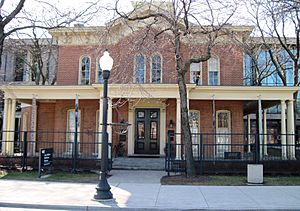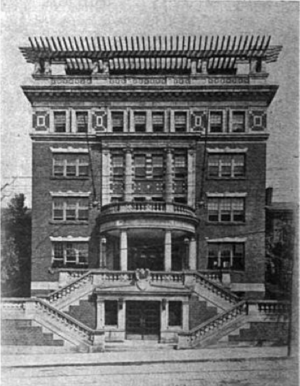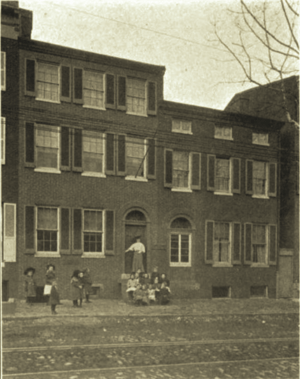Settlement and community houses in the United States facts for kids

Settlement and community houses in the United States were special places that helped people, especially new immigrants and those living in poverty. They were part of a big movement that started in London in the mid-1800s. The main goal was to make life better in poor city areas. They did this by offering classes, providing food and shelter, and helping people learn about their new country.
Contents
History of Settlement Houses

The idea of settlement houses came to the United States in the late 1880s. The first one was the Neighborhood Guild in New York City in 1886. Soon after, in 1889, the most famous one, Hull-House, opened in Chicago. It was started by two amazing women, Jane Addams and Ellen Starr.
These houses grew very quickly. By 1887, there were 74 settlement houses in the U.S. This number jumped to over 400 by 1890! By 1905, New York City alone had 119 of them.
Who Worked There?
People who worked at settlement houses often lived right there. They believed that by living in the neighborhood, they could truly understand what the people needed. However, it was clear that those giving help were different from those receiving it.
Women played a huge part in starting and running these houses. At a time when women usually couldn't be leaders in business or government, they became pioneers in social welfare. They helped create the rules and responsibilities for this important work. This also led to the development of a new field called social work.

Groups like the College Settlements Association, formed in 1890, supported settlement houses run by women. These houses, found in cities like New York, Boston, and Philadelphia, were started and managed mostly by college women.
How They Were Funded
As settlement houses grew, they needed trained professionals. This meant they needed money to pay these workers. Most of the money came from wealthy people who wanted to help. These rich helpers often served on the boards that ran the houses. At first, the government didn't give much money to these community groups.
Helping Newcomers
Settlement houses aimed to welcome immigrants to their new country. They also encouraged people to keep parts of their own cultures. But at the same time, many houses, like the Downtown Community House, also helped immigrants learn English and American values.
For example, at Hull-House, immigrants could take classes in history, art, and literature. Many community houses had special programs to help people become more "American." One report from 1926 said they didn't push immigrants to become citizens. But when immigrants wanted to, the houses gave them all the help they needed with their paperwork.
Working Together: National Conferences
From 1892 to 1910, settlement workers held informal meetings across the country. They met in places like Plymouth, Massachusetts, Chicago, and New York City. These meetings helped them share ideas and work better together.
In 1908, a group of twenty settlement workers from New York, Chicago, and Boston decided they needed to cooperate more. They wanted to study settlement work to find the best ways to help people. They also decided to hold regular meetings during the National Conference of Charities.
The next year, settlement work was a big part of the National Conference. They decided to invite every settlement house in the country to send representatives to the next meeting in St. Louis. Jane Addams was even the president of that conference! At these meetings, a national committee was formed. Their job was to gather all the experiences from settlement houses. They planned to create a plan for united action for all settlements across the country a year later.
Later Years and Changes
In the 1920s, fewer immigrants came to the U.S. because of new laws like the Immigration Act of 1924. This meant settlement houses were used less. Also, many settlement workers wanted to be paid for their work and no longer wanted to live in the houses.
Because of these changes, many settlement houses combined into bigger neighborhood or community centers. They often sold their old buildings and moved into larger, newer ones. In 1979, the National Federation of Settlements changed its name to United Neighborhood Centers of America. This shows how these important places continued to adapt and help communities over time.




